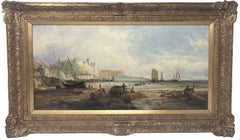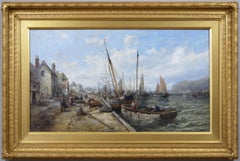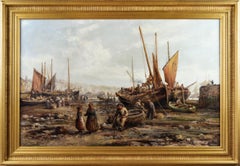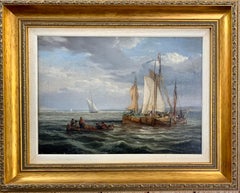William Edward Webb Art
to
3
3
3
1
2
Overall Height
to
Overall Width
to
1
2
2
1
3
3
6,856
3,188
2,516
1,217
3
3
2
2
Artist: William Edward Webb
Hastings Castle oil painting seascape 19th century, William Edward Webb
By William Edward Webb
Located in York, GB
Hastings Castle from the beach oil William Edward Webb
A fine 19th century oil on canvas painting depicting Hastings Castle from the beach with fishermen and boats
housed in a git ...
Category
19th Century Old Masters William Edward Webb Art
Materials
Oil
19th Century seascape oil painting of Douglas Harbour, Isle of Man
By William Edward Webb
Located in Moreton-In-Marsh, Gloucestershire
William Edward Webb
British, (1862-1903)
Douglas Harbour, Isle of Man
Oil on canvas, signed
Image size: 21.5 inches x 37.5 inches
Size including frame: 33 inches x 49 inches
A busy quayside painting by William Edward Webb of Douglas Harbour on the Isle of man. Fishermen in boats can be seen preparing to head ashore as other figures make their way along the quayside.
William Edward Webb was born in Cheltenham, Gloucestershire in 1862 to William Benjamin Webb and Ellen Butler. His father was a printer and an artist and it is highly likely he received tuition from him. Following the death of his mother, his father remarried and moved the family to Manchester sometime after 1871.
By the 1880’s, Webb had started working as an artist and later set up a studio at 30 Exchange Buildings in Manchester. He began exhibiting at the Manchester City Art Gallery from 1890, where he showed more than 60 paintings during his lifetime. He also exhibited at the Royal Academy and Walker Art Gallery Liverpool from 1892. He married Clara Foster in 1899 and the couple lived at 1 Sylvan Grove, Chorlton Upon Medlock in South Manchester with their daughter Florrie. He became friends with the artist Walter Emsley (1860-1938) who also lived in Manchester.
Although he spent the rest of his life in Manchester, Webb travelled throughout the UK painting coastal and marine scenes around the main ports and harbours. He spent a great deal of time in the Isle of Mann painting numerous scenes along the coast including views of Peel and Douglas Harbour, subjects he frequently returned to. Webb painted in a highly distinctive style; loose and informal but which manages to retain the sense of perspective. He struggled with ill health and depression throughout his life which sadly led to his suicide 9 November, 1903. In 1974, a retrospective exhibition was held at The Old Customs House and Old Solent House in Lymington, which brought a new found interest in his work.
His paintings are now highly sought after and are represented in many collections and Museums including the Astley Hall...
Category
19th Century Victorian William Edward Webb Art
Materials
Oil, Canvas
19th Century seascape oil painting of Penzance harbour, Cornwall
By William Edward Webb
Located in Moreton-In-Marsh, Gloucestershire
William Edward Webb
British, (1862-1903)
Penzance Harbour
Oil on canvas, signed
Image size: 29 inches x 45.5 inches
Size including frame: 38 inches x 54.5 inches
A pleasing coastal painting of Penzance Harbour at low tide by William Edward Webb. In the foreground, a fisherman sells his catch to a woman and her daughter, whilst figures in horses and carts wait for others to unload their boats.
William Edward Webb was born in Cheltenham, Gloucestershire in 1862 to William Benjamin Webb and Ellen Butler. His father was a printer and an artist and it is highly likely he received tuition from him. Following the death of his mother, his father remarried and moved the family to Manchester sometime after 1871.
By the 1880’s, Webb had started working as an artist and later set up a studio at 30 Exchange Buildings in Manchester. He began exhibiting at the Manchester City Art Gallery from 1890, where he showed more than 60 paintings during his lifetime. He also exhibited at the Royal Academy and Walker Art Gallery Liverpool from 1892. He married Clara Foster in 1899 and the couple lived at 1 Sylvan Grove, Chorlton Upon Medlock in South Manchester with their daughter Florrie. He became friends with the artist Walter Emsley (1860-1938) who also lived in Manchester.
Although he spent the rest of his life in Manchester, Webb travelled throughout the UK painting coastal and marine scenes around the main ports and harbours. He spent a great deal of time in the Isle of Mann painting numerous scenes along the coast including views of Peel and Douglas Harbour, subjects he frequently returned to. Webb painted in a highly distinctive style; loose and informal but which manages to retain the sense of perspective. He struggled with ill health and depression throughout his life which sadly led to his suicide 9 November, 1903. In 1974, a retrospective exhibition was held at The Old Customs House and Old Solent House in Lymington, which brought a new found interest in his work.
His paintings are now highly sought after and are represented in many collections and Museums including the Astley Hall...
Category
19th Century Victorian William Edward Webb Art
Materials
Oil, Canvas
Related Items
Antique 19th century English fishing vessels In the English Channel
By William Henry Williamson
Located in Woodbury, CT
Antique 19th century English fishing vessels In the English Channel
William Henry Williamson was a gifted, London painter of coastal scenes, ...
Category
1880s Victorian William Edward Webb Art
Materials
Canvas, Oil
Free Shipping
H 14.5 in W 22.5 in
Antique Dutch 19th century ships at sea, fishing boats, men rowing.
Located in Woodbury, CT
A very well-painted Dutch 19th century marine scene. The small boat is full of men who are rowing hard to get to the larger vessels, possibly to either take goods on or off the large...
Category
1870s Victorian William Edward Webb Art
Materials
Canvas, Oil
Free Shipping
H 16 in W 19.5 in
Scottish 19th century Highland landscape, with a figure and cattle on a pathway
By Sidney Richard Percy
Located in Woodbury, CT
Wonderful Scottish 19th century Highland landscape, with a figure and cattle on a pathway overlooking a Loch
This piece is signed lower right and is framed in a Vintage Gold Leaf fr...
Category
1850s Victorian William Edward Webb Art
Materials
Oil, Canvas
Free Shipping
H 17 in W 23 in
A Wolf
Located in New York, NY
Provenance:
The Marchesi Strozzi, Palazzo Strozzi, Florence
Sale, Christie’s, London, May 20, 1993, lot 315, as by Carl Borromaus Andreas Ruthart...
Category
17th Century Old Masters William Edward Webb Art
Materials
Canvas, Paper, Oil
Antique oil 19th century View of Venice, The Grand Canal Venice
By William Meadows
Located in Woodbury, CT
View of the Grand Canal in Venice by one of England's best-known landscape and Venetian painters.
This example is a very well-painted piece and is a great composition.
It is framed in an English Classic running pattern frame.
Tracing the story of William Meadows, the son of James Meadows, is sometimes a little difficult. In earlier census returns he gave his place of birth as Epping, but in later census returns he said that he was born in Mountnessing in about 1825. Between 1841 and 1901 William is recorded as William James, William George, and in 1881 simply as George, and these apparent changes of name were explained by a chaotic personal life which contrasts with his tranquil paintings of the English countryside and Venice.
An entry in The Fine Arts Journal in 1847, concerning the Theatre Royal, Dumfries, reveals that "The scene-painter is Mr. W.J.Meadows, the son of Mr. Meadows, of the Surrey”. Initially, William had begun his career by following in the family footsteps at one of the theatres where his grandfather had performed. However, his training as a scene painter most probably came closer to home under his father's tuition, possibly at The Lyceum Theatre in London in 1844. (See the previous page on James Meadows for further details).
In 1850, William married Lydia Maria Jarvis (born in Norwich c.1826) at St Pancras Old Church, close to St Pancras Station in London. By the time that the census was taken the following year, William and Lydia were living at 16, High Street in Poole, Dorset. So far it has been not been possible to identify a census entry for 1861 for the couple. However, when William exhibited "A scene in Surrey' at the Royal Hibernian Academy of Arts in Dublin in 1865, he gave his address as 187, Hampstead Road, London, not far from the St Pancras area once again.
The reason for William's obscurity in the 1861 census may lie partially in his financial difficulties, as well as his frequent changes of address. In 1864, The Law Journal's list of impending bankruptcy proceedings included an entry for "Meadows, William George (known as William James Meadows), artist, of Old Kent Road, previously of Beal Road, Old Ford, previously of Wanstead Flats, Wanstead". A family source has revealed that William tried changing career not long afterward, when he became the landlord of The Black Bull Inn in Fyfield in Essex on the 9th November 1866, and that he "gave an opening dinner there" on 29th November 1866. However, if William was trying to achieve financial stability by changing careers, the 1871 census would suggest that it was an unsuccessful interlude.
In 1871 William was recorded under the name of William George but is identifiable as the same person by his age, place of birth, and the personal details of his wife. He no longer gave his profession as an artist, but as an "Eating Housekeeper", back in the East End of London and living at 200, High Street in Shoreditch. Two servants were living with the couple, but more unusually there was also another resident, whose occupation was listed as "bailiff in possession". The presence of a live-in bailiff, therefore, seems to suggest that William's financial difficulties were far from over.
In addition to his financial woes, William’s marriage to Lydia also appears to have been a stormy affair. In 1867 in London she petitioned for a divorce from William, although she must have been initially reconciled to him as the couple was living together (with their bailiff!) in 1871. However in 1874, Lydia once again petitioned for a divorce and this time the separation was definitive, and Lydia moved to a separate address in Holborn where she was living at the time of the 1881 census as a "retired publican". William, meanwhile, married for a second time in Southwark in 1875, under the name of William George Meadows.
His second wife, Helen Grace Higgs, was born in Tipperary in Ireland in about 1841. By the time of the 1881 census, the couple was lodging over a pub at 87, High Holborn in London, where William is recorded simply as "George Meadows, Landscape painter". In the 1891 census, the couple was lodging at The Green Dragon...
Category
1890s Victorian William Edward Webb Art
Materials
Oil, Canvas
Free Shipping
H 28 in W 38 in
Early oil depicting the Great Fire of London
Located in London, GB
The Great Fire of London in September 1666 was one of the greatest disasters in the city’s history. The City, with its wooden houses crowded together in narrow streets, was a natural fire risk, and predictions that London would burn down became a shocking reality. The fire began in a bakery in Pudding Lane, an area near the Thames teeming with warehouses and shops full of flammable materials, such as timber, oil, coal, pitch and turpentine. Inevitably the fire spread rapidly from this area into the City. Our painting depicts the impact of the fire on those who were caught in it and creates a very dramatic impression of what the fire was like. Closer inspection reveals a scene of chaos and panic with people running out of the gates. It shows Cripplegate in the north of the City, with St Giles without Cripplegate to its left, in flames (on the site of the present day Barbican). The painting probably represents the fire on the night of Tuesday 4 September, when four-fifths of the City was burning at once, including St Paul's Cathedral. Old St Paul’s can be seen to the right of the canvas, the medieval church with its thick stone walls, was considered a place of safety, but the building was covered in wooden scaffolding as it was in the midst of being restored by the then little known architect, Christopher Wren and caught fire. Our painting seems to depict a specific moment on the Tuesday night when the lead on St Paul’s caught fire and, as the diarist John Evelyn described: ‘the stones of Paul’s flew like grenades, the melting lead running down the streets in a stream and the very pavements glowing with the firey redness, so as no horse, nor man, was able to tread on them.’
Although the loss of life was minimal, some accounts record only sixteen perished, the magnitude of the property loss was shocking – some four hundred and thirty acres, about eighty per cent of the City proper was destroyed, including over thirteen thousand houses, eighty-nine churches, and fifty-two Guild Halls. Thousands were homeless and financially ruined. The Great Fire, and the subsequent fire of 1676, which destroyed over six hundred houses south of the Thames, changed the appearance of London forever. The one constructive outcome of the Great Fire was that the plague, which had devastated the population of London since 1665, diminished greatly, due to the mass death of the plague-carrying rats in the blaze.
The fire was widely reported in eyewitness accounts, newspapers, letters and diaries. Samuel Pepys recorded climbing the steeple of Barking Church from which he viewed the destroyed City: ‘the saddest sight of desolation that I ever saw.’ There was an official enquiry into the causes of the fire, petitions to the King and Lord Mayor to rebuild, new legislation and building Acts. Naturally, the fire became a dramatic and extremely popular subject for painters and engravers. A group of works relatively closely related to the present picture have been traditionally ascribed to Jan Griffier...
Category
17th Century Old Masters William Edward Webb Art
Materials
Oil, Canvas
19th century Fall English landscape with figures on a path in the highlands
By Benjamin Williams Leader
Located in Woodbury, CT
Wonderful Autumn/Fall landscape by one of Englands finest landscape painters.
Born as Benjamin Williams, the artist added the surname Leader (his Father’s middle name) to distingui...
Category
1880s Victorian William Edward Webb Art
Materials
Canvas, Oil
Free Shipping
H 16 in W 20 in
A park
Located in Genève, GE
Work on cardboard
Plaster and gilded wood frame
46 x 55.5 x 5 cm
Category
Mid-19th Century Old Masters William Edward Webb Art
Materials
Oil
19th century English marine Sailing scene of Dutch fishing boats by a harbor
By Henry King Taylor
Located in Woodbury, CT
Henry King Taylor was a marine and coastal scene painter who lived in London. He exhibited at the Royal Academy from 1859 to 1864 with titles includi...
Category
1850s Victorian William Edward Webb Art
Materials
Canvas, Oil
Henry King Taylor19th century English marine Sailing scene of Dutch fishing boats by a harbor , 1859
Free Shipping
H 21 in W 33 in
Connemara, Near Roundstone
By Martin Mooney
Located in Belfast, GB
Connemara, Near Roundstone
Oil on Board
36 x 38 in
91.4 x 96.5 cm
Regarded as one of Ireland’s most accomplished fine art painters, Martin Mooney was born in 1960, in Belfast, North...
Category
2010s Old Masters William Edward Webb Art
Materials
Oil
Early 20th Century English Autumn river landscape with a Norman Church
By Abraham Hulk the Younger
Located in Woodbury, CT
Early 20th Century English Autumn river landscape with a Norman Church.
Abraham Hulk Junior was born in the Netherlands in 1851 to renowned Dutch ...
Category
1890s Victorian William Edward Webb Art
Materials
Canvas, Oil
Free Shipping
H 20 in W 16 in
A Pair of Forest Landscapes, Philipp H. Brinckmann, 1709 – 1761, Old Master
Located in Bruges, BE
A Pair of Forest Landscapes with River and Boat in the Foreground
Brinckmann Philipp Hieronymus
Spire 1709 – 1761 Manheim
Old Master
Signature: Signed "Ph. Brinckm" bottom lower lef...
Category
18th Century Old Masters William Edward Webb Art
Materials
Copper
H 13.78 in W 16.54 in D 1.58 in
Previously Available Items
On the Coast of Holland
By William Edward Webb
Located in London, GB
William Edward Webb (1862-1903)
On the Coast of Holland
Signed 'W.E. Webb' and dated '1876'
oil on canvas
12.5 x 17.5 inches, inc. frame
A success story nearly 100 years in the maki...
Category
Late 19th Century Post-Impressionist William Edward Webb Art
Materials
Oil
Chestnut Mare in a stable
By William Edward Webb
Located in Woodbury, CT
William Edward Webb
English sporting painter from the early to middle period of the 19th century.
Webb was a specialist in horse portraits and his work is close to the paintings of...
Category
Mid-19th Century William Edward Webb Art
Materials
Oil
Market Day in a Coastal Town, oil on canvas
By William Edward Webb
Located in Moreton-In-Marsh, Gloucestershire
William Edward Webb
British, (1862-1903)
Market Day in a Coastal Town
Oil on canvas, signed & dated ‘83
Image size: 9 inches x 7 inches
Size including frame: 13 inches x 11 inches
William Webb was born in Manchester in 1862. Although he lived all his life in Manchester he travelled throughout the UK painting coastal and marine scenes around the main ports and harbours. He also spent a great deal of time in the Isle of Mann painting numerous scenes along the coast. He exhibited at the Manchester City Art Gallery with more than 60 paintings during his lifetime. He also exhibited at the Walker Art Gallery Liverpool between 1892-1902 as well as at the Royal Academy from 1892-1902. Webb painted in a highly distinctive style; loose and informal but which manages to retain the sense of perspective. He struggled with ill health and depression throughout his life which sadly led to his suicide in 1903. In 1974 a retrospective exhibition was held at The Old Customs House and Old Solent House in Lymington, which brought a new found interest in his work. His paintings are highly sought after and are represented in many collections and Museums including the Astley Hall...
Category
19th Century Victorian William Edward Webb Art
Materials
Canvas, Oil
William Edward Webb art for sale on 1stDibs.
Find a wide variety of authentic William Edward Webb art available for sale on 1stDibs. You can also browse by medium to find art by William Edward Webb in canvas, fabric, oil paint and more. Not every interior allows for large William Edward Webb art, so small editions measuring 49 inches across are available. Customers who are interested in this artist might also find the work of William Shayer Senior, Walter Williams, and Adolphus Knell. William Edward Webb art prices can differ depending upon medium, time period and other attributes. On 1stDibs, the price for these items starts at $12,352 and tops out at $13,603, while the average work can sell for $12,977.





